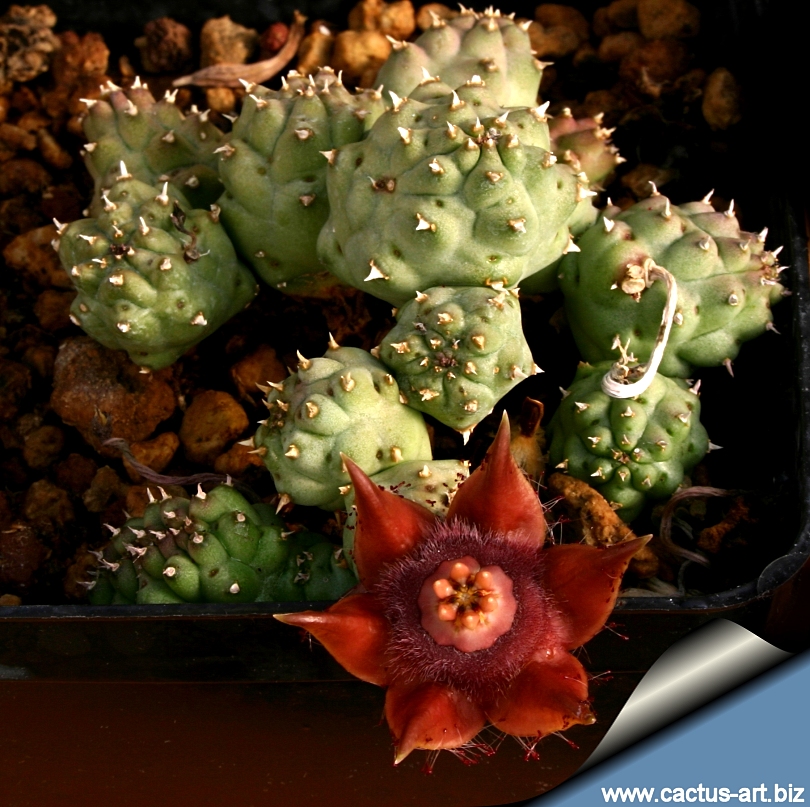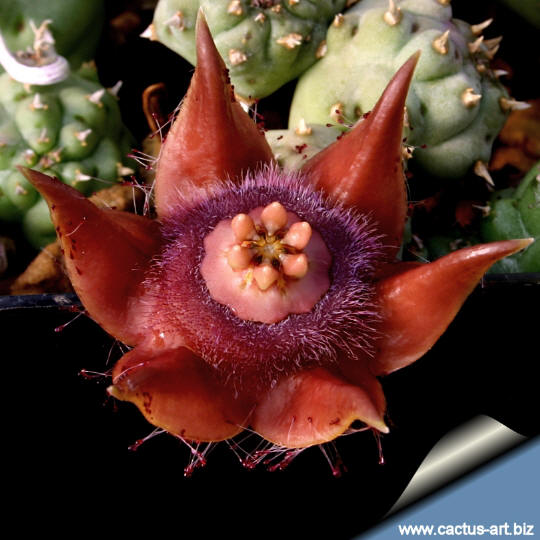|
|
|

Of all the duvalias, this specie is among the most distinct and has the
largest flowers
reaching almost 5 cm in diameter. The attractive brick-red flower is
also unusual
in having long purple hairs thickly covering the centre of the flower.
Purplish colour simulate the
rotting flesh of dead animals. These flowers
attract
beetles and carrion
flies who
pollinate the plant as they are fooled into trying to lay eggs on
the flower. |
| |
|
Morphology (Identifying
Characteristics): Groundcover,
clump forming. This species is easily identifiable by
its thick six angled stems and its relatively large fleshy and very
hairy flowers. These plants grow covering the whole land at their
disposal.
Stem: Stems are typical for the genus in being small and
creeping. Branches sub-globose, crowded, thick, leafless, decumbent and
rooting, glabrous, dull green or purplish, six-angled; angles obtuse,
toothed. In autumn, winter it may assumes a yellow/green colouring,
it also tends to
redden in
full sun and during the
winter month.
Flower: From the sides of the stems, olive-green, with
darker tips, or dull reddish-brown, 1 1/2in. to 2in. in diameter; lobes
of corolla lanceolate-acuminate, fringed with clavate mauve-purple
hairs; annulus clothed with soft hairs of the same colour. Different
colored flowers can be produced produced on the same plant but not on
the same branch.
Fruit:
Flies pollinate the flowers resulting in the typical twin seed horns
(follicles),
which are decorative in themselves and often don't appear until a year
later.
Blossoming time: Flowers are freely produced throughout the late
summer and
autumn.
Notes: D. corderoy is a variable species with many
different forms and clones both in the
wild and
in cultivation. |
Cultivation: It
is an easy obliging
blooming plant when
mature, they are happy in any average succulent house.
Duvalia require moderately watering through the
growing season but enjoy plenty of water and some
fertiliser in hot
weather, this helps them to
flower freely.
Fertilizers fur succulent plants must be rich in potassium, but
poor in nitrogen, to avoid the plants from developing excess vegetation,
which is easily attacked by fungal diseases. Water more sparingly in winter according to
temperatures. But, as with most
asclepiads, it is unwise to leave them wet in cold weather.
These plants don't like cold weather, therefore in the Spring it
is best to set them outside only when the temperatures are above 15°C.
It is advisable to position this plant in a partially shady place, where
it is exposed to direct sunlight only during the coolest hours of the
day. Can endure temperatures below 5°C for short period, but only if the
soil stays completely dry. Since
roots are quite shallow, use a soft and incoherent
cactus mix or add extra
perlite or
pumice to regular soil
potting soil, and
clay pots help the plants to dry out between watering.
Sun Exposure: Partial sun or
light shade
Pest and
diseases: Stapelia species vary in their
susceptibility to
rotting, but are generally fairly easy to grow, especially if kept
pest-free. They are very
susceptible to stem and root
mealy bugs, and damage from these may well initiate
fungal
attack. If you do have problems with a stem or with basal
rotting, you can reliably isolate the
healthy parts, dry them off, and
re-root them in moist
compost.
Cultural Practices:
Re-pot every 2 years. |
|
Advertising
|
|
|
|
Family:
Asclepiadaceae (Apocynaceae)
(Milkweeds family)
Scientific Name: Duvalia corderoyi (Hooker f.) N.
E. Brown, 1876
|
Vernacular name (s):
Starfish flower,
Carrion Plant
|
|
Distribution: D. corderoyi is a small stapeliad from the
dry Southwestern and central regions of Southern Africa (Great and Upper
Karoo)
Etymology:
The
genus
epithet "Duvalia" was
named after H. A. Duval (1777-1814) of Paris, a
French botanist and physician, author of " Enumeratio Plantarum
Succulentarum in Horto Alenconio ").
The
species name "corderoyi" comes from
Justus Corderoy (1832-1911) English miller and succulent plant
cultivator at Blewbury near Didcot, Berckshire (Now Oxfordshire)
|
|
Genus Duvalia
Duvalia is a Stapelia-like genus comprising small stem succulent plants
with a creeping or mat forming habit, growing generally in the shade of
shrubs. Corolla with the segments more or less replicate, and an
elevated annulus (orb) on the disk; outer corona flat, entire,
pentagonal, disk-like; inner corona of five small, entire, horizontal,
ovoid, pointed, fleshy segments, somewhat resembling a bird's head when
viewed sideways. Most of the species are natives of South Africa, but
the distribution is disjunct, with section Arabica species found in the
Arabian peninsula and the Horn of Africa, i.e. Saudi Arabia, Yemen,
Sudan, Djibouti, Ethiopia and Somalia in the north, whilst section
Duvalia comprises species from southern Africa which are found in
Botswana, Malawi, Mozambique, Namibia, Zambia, Zimbabwe, and South
Africa.
|
|
|
|

This photo shows the nice symmetry of the flower, note the purplish
hairs covering the uplifted 'ring' or annulus, as well as the yellowish
club-shaped lobes in the centre. See also the
lanceolate-acuminate lobes of corolla fringed with clavate mauve-purple
hairs.
|
|
Propagation: Easiest with stem
cuttings. Allow cuttings to
dry a day before
planting. Stems must be laid (Not buried) on
gritty
compost and will then
root from the underside of the
stems. It can also be increased from seeds
sowing in
spring in moist,
sandy
peat moss. Barely cover seeds. Seeds
germinate quickly.

 |
|